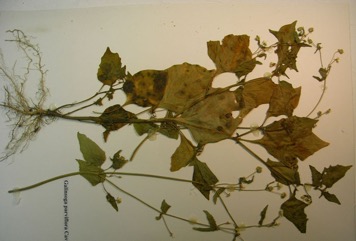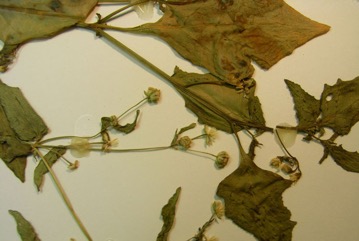Small-flowered quickweed, Potato weed

A tropical and subtropical plant. It will grow in most soils and under most conditions. It can tolerate drought and frost. In Papua New Guinea it grows from 900 to 2500 m altitude. It can grow in arid places but is best with medium to high rainfall. Seeds need a temperature between 10-35°C to germinate. They also need light to germinate. In Zimbabwe it grows between 1,370-1,660 m above sea level. In Ecuador it grows between 1,500-3,000 m above sea level. In Argentina it grows from sea level to 2,500 m above sea level. Tasmania Herbarium. In Yunnan.
Also known as:
Albahaca silvestre, Bribil, Chickweed, Churuman, Co tho, Djaringan lanang, Gallant soldier, Guascas, Kinyoki, Knopkruid, Mabuyejazi, Mamboleo, Mngeeza, Mngereza, Mondreng, Munukepei, Msekeseke, Mwamuna aligone, Nawabijia, Ndevhedzamphobo, Ngereza, Ngwakhoza, Otikidyeri, Patelele, Peeplo, Picao-branco, Quickweed, Selegreng, Sutanuli, Tedar ao, Tedur-ow, Vi cuc, Yamuofie, Yellow weed, Yeshewa-arem, Youcong
Synonyms
- Adventina parviflora Raf.
- Galinsoga quinqueradiata R. & P.
- Stemmatella sodiroi Hieron.
- Wiborgia acmella Roth
- Wiborgia parviflora (Cav.) Kunth
Edible Portion
- Leaves, Vegetable, Flower shoots
Where does Small-flowered quickweed grow?
Found in: Africa, Angola, Argentina, Asia, Australia, Austria, Azores, Belgium, Bolivia, Botswana, Brazil, Britain, Bulgaria, Cameroon, Canada, Cape Verde, Central Africa, Central America, Chile, China, Congo, Czech Republic, Denmark, Dominican Republic, East Africa, Easter Island, Ecuador, Eswatini, Ethiopia, Finland, France, Germany, Haiti, Hawaii, Himalayas, India, Indochina, Indonesia, Italy, Jamaica, Kenya, Korea, Luxembourg, Malawi, Malaysia, Mexico, Mozambique, Myanmar, Netherlands, New Zealand, Norfolk Island, North America, Northeastern India, Norway, NW India, Pacific, Papua New Guinea, PNG, Paraguay, Peru, Poland, Portugal, Romania, Rwanda, Sao Tome and Principe, Scandinavia, SE Asia, Slovakia, Slovenia, South Africa, Southern Africa, South America, Sudan, Swaziland, Sweden, Switzerland, Tanzania, Tasmania, Tibet, Uganda, Uruguay, United States, Vietnam, West Africa, West Indies, Yugoslavia, Zambia, Zimbabwe
Notes: There are about 14 Galinsoga species. The leaves are 11% protein. It can spread and become a difficult to remove weed.
Status: It is a commercially cultivated vegetable. It is only a minor vegetable available in a few local markets. It is popular in some places.
Growing Small-flowered quickweed, Potato weed
Cultivation: Plants are grown from seed. Often they are self sown. The seeds germinate quickly and young plants grow rapidly.
Edible Uses: The leaves and the young stems can be eaten raw or cooked. They are used as a potherb or added to soups and stews. They are used as seasoning. They can be put into stir-fries. It is also dried and ground into a green powder and added to soups and stews especially with chicken. The fresh juice is drunk with other vegetable juices. The flowering shoots are eaten raw or cooked and in soups and stews.
Production: The plant grows rapidly. The leaves should be picked before plants start to form seeds.
Nutrition Info
per 100g edible portion| Edible Part | Energy (kcal) | Protein (g) | Iron (mg) | Vitamin A (ug) | Vitamin c (mg) | Zinc (mg) | % Water |
|---|---|---|---|---|---|---|---|
| Leaves | 41 | 3.3 | 5.3 | - | 12 | 1.3 | 88.4 |
Small-flowered quickweed, Potato weed Photos


References
Ambasta, S.P. (Ed.), 2000, The Useful Plants of India. CSIR India. p 229
Bodkin, F., 1991, Encyclopedia Botanica. Cornstalk publishing, p 484
Burkill, H. M., 1985, The useful plants of west tropical Africa, Vol. 1. Kew.
Burkill, I.H., 1966, A Dictionary of the Economic Products of the Malay Peninsula. Ministry of Agriculture and Cooperatives, Kuala Lumpur, Malaysia. Vol 1 (A-H) p 1060
Bvenura, C. and Afolayan, A. J., 2017, Tackling food and nutrition insecurity using leafy wild vegetables: The nutritional compositions of some selected species.
Casas, A., et al, 1996, Plant Management Among the Nahua and the Mixtec in the Balsas River Basin, Mexico: An Ethnobotanical Approach to the Study of Plant Domestication. Human Ecology, Vol. 24, No. 4 pp. 455-478
Cerne, M., 1992, Wild Plants from Slovenia used as Vegetables. Acta Horticulturae 318
Cribb, A.B. & J.W., 1976, Wild Food in Australia, Fontana. p 121
Curtis, W.M., 1963, The Students Flora of Tasmania Vol 2 p 349
Elias, T.S. & Dykeman P.A., 1990, Edible Wild Plants. A North American Field guide. Sterling, New York p 159
Esperanca, M. J., 1988. Surviving in the wild. A glance at the wild plants and their uses. Vol. 2. p 169
Facciola, S., 1998, Cornucopia 2: a Source Book of Edible Plants. Kampong Publications, p 38
Farfan, B., et al, 2007, Mazahua Ethnobotany and Subsistence in the Monarch Butterfly Biosphere Reserve, Mexico. Economic Botany 61(2) 2007, pp 173-191
Flora of Australia Volume 49, Oceanic Islands 1, Australian Government Publishing Service, Canberra. (1994) p 401
Fowler, D. G., 2007, Zambian Plants: Their Vernacular Names and Uses. Kew. p 12
Gangwar, A. K. & Ramakrishnan, P. S., 1990, Ethnobotanical Notes on Some Tribes of Arunachal Pradesh, Northeastern India. Economic Botany, Vol. 44, No. 1 pp. 94-105
Geng, Y., et al, 2016, Traditional knowledge and its transmission of wild edibles used by the Naxi in Baidi Village, northwest Yunnan province. Journal of Ethnobiology and Ethnomedicine. 12:10
Goode, P., 1989, Edible Plants of Uganda. FAO p 30
Grubben, G. J. H. and Denton, O. A. (eds), 2004, Plant Resources of Tropical Africa 2. Vegetables. PROTA, Wageningen, Netherlands. p 299
Harkonen, M. & Vainio-Mattila, K., 1998, Some examples of Natural Products in the Eastern Arc Mountains. Journal of East African Natural History 87:265-278
Henty, E.E., & Pritchard, G.S., 1973, Weeds of New Guinea and their control. Botany Bulletin No 7, Division of Botany, Lae, PNG. p 79
High, C. & Shackleton, C. M., 2000, The comparative value of wild and domestic plants in home gardens of a South African rural village. Agroforestry Systems 48: 141–156, 2000
Hussey, B.M.J., Keighery, G.J., Cousens, R.D., Dodd, J., Lloyd, S.G., 1997, Western Weeds. A guide to the weeds of Western Australia. Plant Protection Society of Western Australia. p 98
Icon. 3(2):41, t. 281. 1795-1796
Jackes, B.R., 2001, Plants of the Tropics. Rainforest to Heath. An Identification Guide. James Cook University. p 43
Ju, Y., et al, 2013, Eating from the wild: diversity of wild edible plants used by Tibetans in Shangri-la region, Yunnan, China, Journal of Ethnobiology and Ethno medicine 9:28
Kays, S. J., and Dias, J. C. S., 1995, Common Names of Commercially Cultivated Vegetables of the World in 15 languages. Economic Botany, Vol. 49, No. 2, pp. 115-152
Khan, M. & Hussain, S., 2014, Diversity of wild edible plants and flowering phenology of district Poonch (J & K) in the northwest Himalaya. Indian Journal of Sci, Res. 9(1): 032-038
Kinupp, V. F., 2007, Plantas alimenticias nao-convencionais da regiao metropolitana de Porto Alegre, RS, Brazil p 67
Kiple, K.F. & Ornelas, K.C., (eds), 2000, The Cambridge World History of Food. CUP p 1841
Lazarides, M. & Hince, B., 1993, Handbook of Economic Plants of Australia, CSIRO. p 117
Long, C., 2005, Swaziland's Flora - siSwati names and Uses http://www.sntc.org.sz/flora/
Low, T., 1991, Wild Herbs of Australia and New Zealand. Angus & Robertson. p 91 (Drawing)
Low, T., 1992, Bush Tucker. Australia’s Wild Food Harvest. Angus & Robertson. p 156
Lyimo, M., et al, 2003, Identification and nutrient composition of indigenous vegetables of Tanzania. Plant Foods for Human Nutrition. 58: 85-92
MacKinnon, A., et al, 2009, Edible & Medicinal Plants of Canada. Lone Pine. p 355
Magwede, K., van Wyk, B.-E., & van Wyk, A. E., 2019, An inventory of Vhavenḓa useful plants. South African Journal of Botany 122 (2019) 57–89
Maroyi, A., 2013, Use of weeds as traditional vegetables in Shurugwi District, Zimbabwe. Journal of Ethnobiology and Ethnomedicine 9:60
Martin, F.W. & Ruberte, R.M., 1979, Edible Leaves of the Tropics. Antillian College Press, Mayaguez, Puerto Rico. p 185
Maundu, P. et al, 1999, Traditional Food Plants of Kenya. National Museum of Kenya. 288p
Molla, A., Ethiopian Plant Names. http://www.ethiopic.com/aplants.htm
Msuya, T. S., et al, 2010, Availability, Preference and Consumption of Indigenous Foods in the Eastern Arc Mountains, Tanzania, Ecology of Food and Nutrition, 49:3, 208-227
Murtem, G. & Chaudhrey, P., 2016, An ethnobotanical note on wild edible plants of Upper Eastern Himalaya, India. Brazilian Journal of Biological Sciences, 2016, v. 3, no. 5, p. 63-81
Mutie, F. G., 2020, Conservation of Wild Food Plants and Their Potential for Combatting Food Insecurity in Kenya as Exemplified by the Drylands of Kitui County. Plants 2020, 9, 1017
Ochse, J.J. et al, 1931, Vegetables of the Dutch East Indies. Asher reprint. p 134
Paczkowska, G. & Chapman, A.R., 2000, The Western Australian Flora. A Descriptive Catalogue. Western Australian Herbarium. p
Plants of Haiti Smithsonian Institute http://botany.si.edu
Quintana, C. M., 2010, Wild Plants in the Dry Valleys Around Quito Ecuador. An Illustrated Guide. Publicationes del Harbario, QCA p 72
Royal Botanic Gardens, Kew (1999). Survey of Economic Plants for Arid and Semi-Arid Lands (SEPASAL) database. Published on the Internet; http://www.rbgkew.org.uk/ceb/sepasal/internet [Accessed 11th April 2011]
Ruiters-Welcome, A. K., 2019, Food plants of southern Africa. Ph.D. thesis. Univ. of Johannesburg p 34
Tabuti, J.R.S., 2007. Flueggea virosa (Roxb. ex Willd.) Voigt. [Internet] Record from Protabase. Schmelzer, G.H. & Gurib-Fakim, A. (Editors). PROTA (Plant Resources of Tropical Africa), Wageningen, Netherlands. < http://database.prota.org/search.htm>. Accessed 16 October 2009.
Shackleton, S. E., et al, 1998, Use and Trading of Wild Edible Herbs in the Central Lowveld Savanna Region, South Africa. Economic Botany, Vol. 52, No. 3, pp. 251-259
Stanley, T. D. & Ross, E. M., 1986, Flora of south-eastern Queensland Volume 2. Queensland Government p 563
Tanaka, Y. & Van Ke, N., 2007, Edible Wild Plants of Vietnam: The bountiful garden. Orchid books. p 46
Tasmanian Herbarium Vascular Plants list p 6
Vainio-Mattila, K., 2000, Wild vegetables used by the Sambaa in the Usumbara Mountains, NE Tanzania. Ann. Bot. Fennici 37:57-67
Vernon, R., 1983, Field Guide to Important Arable Weeds of Zambia. Dept of Agriculture, Chilanga, Zambia. p 90
Wehmeyer, A. S, 1986, Edible Wild Plants of Southern Africa. Data on the Nutrient Contents of over 300 species.
Williamson, J., 2005, Useful Plants of Malawi. 3rd. Edition. Mdadzi Book Trust. p 120
World Checklist of Useful Plant Species 2020. Royal Botanic Gardens, Kew
Wujisguleng, W., & Khasbagen. K., 2010, An integrated assessment of wild vegetable resources in Inner Mongolian Autonomous Region, China. Journal of Ethnobiology and Ethnomedicine 6:34
Xu, You-Kai, et al, 2004, Wild Vegetable Resources and Market Survey in Xishuangbanna, Southwest China. Economic Botany. 58(4): 647-667.
Zizka, G., 1991, Flowering Plants of Easter Island. Palmarum Hortus Francofurtensis